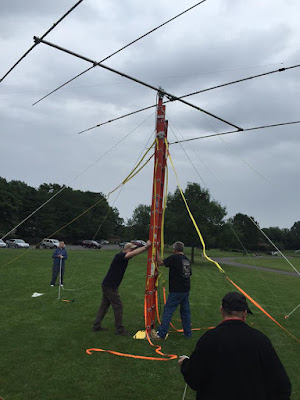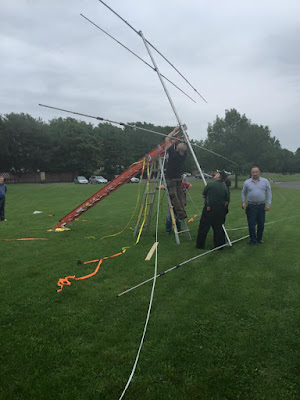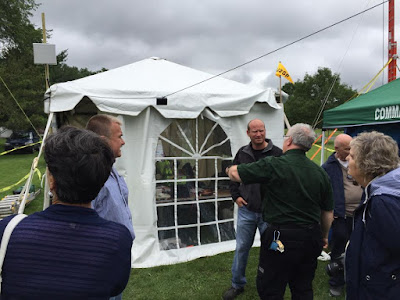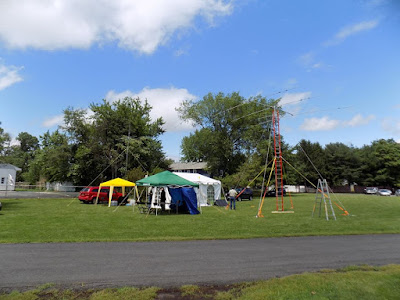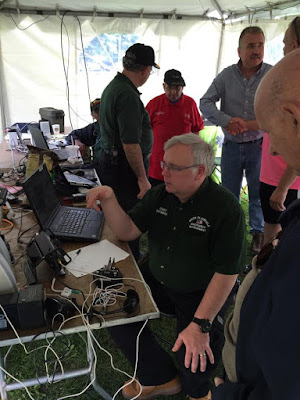Posts Tagged ‘emcomm’
 Field Day 2015 – Comprehensive Report
Field Day 2015 – Comprehensive Report
First - set up the antennas, and organize the tent - our "home" for the next 24+ hours.
 We Call It “Tech Field Day”
We Call It “Tech Field Day”
For Field Day this year, the Tri-Lakes Monument Radio Association (WØTLM) is planning a one day event that combines our Tech Day training activities with normal Field Day radio operating. This Tech Field Day will have a strong emphasis on radio education and training, including an opportunity to make contacts on the HF bands under the supervision of an experienced radio ham.
Sat June 27th, 2015 (8:00 AM to 5 PM)
Location: Black Forest Fire Station 1
11445 Teachout Road, Colorado Springs
Come to our one-day education and radio operating event and learn from informative presentations of amateur radio topics. Operate a high frequency (HF) radio station with the helpful guidance of an experienced radio ham. Learn about emergency communications and public service. Most of all, have a bunch of fun messing around with ham radio stuff!
| Time | Activity | Presenter |
| 8:00 | Setup starts | |
| 8:30 | FM Simplex and Repeaters | Bob Witte, KØNR |
| 9:30 | Operating SSB on the HF Bands | Stu Tuner, WØSTU |
| 10:30 | Construction of Dipole Antennas | Larry Kral, NØAMP |
| 11:30 | Summits On The Air (SOTA) | Steve Galchutt, WGØAT |
| 12:00 | Start Field Day Operating | |
| 13:30 | Copper pipe antennas | Al Andzik, WBØTGE |
| 14:30 | Emergency Power for Ham Radio | Mike Hoskins, WØMJH |
| 15:30 | Ask an Elmer Panel | Bob Witte KØNR and crew |
| 17:00 | End of operations – tear down |
For more information, visit the W0TLM web site.
73, Bob K0NR
The post We Call It “Tech Field Day” appeared first on The KØNR Radio Site.
 Good Operating Habits on Field Day
Good Operating Habits on Field Day
In preparation for ARRL Field Day, I will be doing a presentation at our radio club meeting, explaining how FD works. We have lots of newer hams, so I want to cover the basics well. I looked around on YouTube for some video of typical Field Day contacts so our members could hear what it sounds like.
This video shows Andy K5PO doing an outstanding job of operating the WR5P Noise Blankers Field Day station. Give a listen and notice how he keeps the contacts short and to the point, clearly communicating using phonetics.
73, Bob K0NR
The post Good Operating Habits on Field Day appeared first on The KØNR Radio Site.
 Can I Use My Ham Radio on Public Safety Frequencies? Updated
Can I Use My Ham Radio on Public Safety Frequencies? Updated
This is an update to one of my most popular posts.
 We have quite a few licensed radio amateurs that are members of public safety agencies, including fire departments, law enforcement agencies and search and rescue. Since they are authorized users of those public safety channels, they often ask this question:
We have quite a few licensed radio amateurs that are members of public safety agencies, including fire departments, law enforcement agencies and search and rescue. Since they are authorized users of those public safety channels, they often ask this question:
Can I use my VHF/UHF ham radio on the fire, police or SAR channel?
It is widely known that many amateur radios can be modified to transmit outside the ham bands. The answer to this question used to be that amateur radio equipment cannot be used legally on public safety channels because it is not approved for use under Part 90 of the FCC Rules. (Part 90 covers the Private Land Mobile Radio Services.) The only option was to buy a commercial radio with Part 90 approval and a frequency range that covered the desired amateur band. Some commercial radios tune easily to the adjacent ham band but some do not. The commercial gear is usually two to three times as expensive as the amateur gear, and just as important, does not have the features and controls that ham operators expect. Usually, the commercial radios do not have a VFO and are completely channelized, typically changeable only with the required programming software.
The situation has changed dramatically in the past few years. Several wireless manufacturers in China (Wouxun, Baofeng, Anytone, etc.) have introduced low cost handheld transceivers into the US amateur market that are approved for Part 90 use. These radios offer keypad frequency entry and all of the usual features of a ham radio. It seems that these radios are a viable option for dual use: public safety and amateur radio, with some caveats.
New radios are being introduced frequently, so I won’t try to list them here. However, you might want to do a search on Wouxun, Baofeng and Anytone for the latest models. I will highlight the Anytone NSTIG-8R radio which I have been using. It seems to be a well-designed but still affordable (<$75) handheld radio. See the review by PD0AC.
Some Things to Consider When Buying These Radios
- The manufacturers offer several different radios under the same model number. Also, they are improving the radios every few months with firmware changes and feature updates. This causes confusion in the marketplace, so buy carefully.
- Make sure the vendor selling the radio indicates that the radio is approved for Part 90 use. I have seen some radios show up in the US without an FCC Part 90 label.
- Make sure the radio is specified to tune to the channels that you need.
- The 2.5-kHz tuning step is required for some public safety channels. For example, a 5-kHz frequency step can be used to select frequencies such as 155.1600 MHz and 154.2650 MHz. However, a 2.5 kHz step size is needed to select frequencies such as 155.7525 MHz. There are a number of Public Safety Interoperability Channels that require the 2.5-kHz step (e.g., VCALL10 155.7525 MHz, VCALL11 151.1375 MHz, VFIRE24 154.2725). The best thing to do for public safety use is to get a radio that tunes the 2.5-kHz steps.
- Many of these radios have two frequencies in the display, but only have one receiver, which scans back and forth between the two selected frequencies. This can be confusing when the radio locks onto a signal on one of the frequencies and ignores the other. Read the radio specifications carefully.
Recommendation
There are a number of reasonably good radios out there from various manufacturers. My favorite right now is the Anytone NSTIG-8R but I also like the Wouxun KG-UV6D. The Baofeng UV-5R continues to be popular in the amateur community as the low cost leader. However if you show up at an incident with the Baofeng, your fellow first responders will think it is a toy. Which leads to a really important point: the established commercial radio manufacturers such as Motorola, Vertex, etc. build very rugged radios. They are made for frequent, heavy use by people whose main job is putting out fires, rescuing people in trouble and dealing with criminals. These low cost radios from China are not in the same league. However, they can still serve in a less demanding physical environment while covering the Amateur Radio Service (FCC Part 97) and the Private Land Mobile Radio Services (FCC Part 90).
73, Bob K0NR
The post Can I Use My Ham Radio on Public Safety Frequencies? Updated appeared first on The KØNR Radio Site.
 Hams doing what they do best
Hams doing what they do best
4/27/2015
As the death toll climbs in the wake of the devastating magnitude 7.9 earthquake in Nepal, rescue and recovery work is continuing, and Amateur Radio volunteers have been a part of it. The earthquake — said to be the worst in Nepal in 80 years — hit an area between the capital city of Kathmandu and the city of Pokhara. An emergency net had been running around the clock on 20 meters with Jayu Bhide, VU2JAU, as net control station and other stations in India participating. Bhide is the Amateur Radio Society of India National Coordinator for Disaster Communication.
The Nepal disaster has claimed more than 3200 lives and wreaked widespread damage. Many others are missing or have been injured. Hospitals have been flooded with those who suffered serious injuries in the earthquake. Persistent aftershocks continue to terrorize those who managed to escape harm. On Mount Everest an avalanche devastated base camp, and at least 100 climbers were stranded on the mountain. Several mountaineers were reported among the dead.
Hams in India have been among the most active responders. Parts of eastern India also suffered earthquake damage. Within Nepal, members of the Nepal Amateur Radio Society are reported to be active on HF emergency nets as well as on VHF/UHF to handle local traffic.
“The situation in Nepal is getting worse, as tremors continue to strike every hour at a magnitude of 4.7,” Bhide said. The government of Nepal has asked all people to stay out of buildings, as damage is expected to increase. Due to the conditions, emergency communication with 9N1 stations came to a standstill; no communication was possible overnight as the earthquake demolished the building where emergency communication gear was installed.”
He said Satish Kharel, 9N1AA, and his daughter Tej, 9N1DX, were able to return to the air this morning. Both are in Kathmandu. 9N1AA has said he’s operating low power with the help of solar power and coordinating with the Nepal police in Kathmandu. Suresh Upreti, 9N1HA, has been assisting with emergency communication as well. Internet service has been spotty in Nepal at best. So far, there has been no cross-border movement of either radio equipment and radio amateurs.
Sanjeeb Panday, 9N1SP, has indicated that he will be on 21.360 MHz at 1645 UTC, and radio amateurs not involved in the disaster response should avoid this frequency. 9N1SP has intermittent Internet service. He has said that propagation on 20 meters, where an initial emergency net was established was poor, but he has been in contact on 15 meters with Tim McFadden, KB2RLB/T6TM, a Military Auxiliary Radio System (MARS) member in Afghanistan.
Ironically, McFadden, Kharel, Panday, and others took part in MARS exercises in 2013 and 2014 in which the emergency scenario was an earthquake in Nepal. Army MARS Program Officer Paul English, WD8DBY, said the response to this earthquake followed the procedures trained during those earlier exercises. McFadden had been scanning International Amateur Radio Union (IARU) Global Emergency Center of Activity (GECOA) frequencies for stations in Nepal. GECOA frequencies were established as places to pass emergency traffic. Worldwide GECOA frequencies are 21.360 MHz, 18.160 MHz, 14.300 MHz, 7.240 MHz, 7.060 MHz, 3.985 MHz, and 3.750 MHz.
Nepal’s first Amateur Radio repeater, set up in 2012 by the National Society for Earthquake Technology (NSET), and at least a dozen ham in various locations were reported on VHF. The 9N1KS repeater (434.500 MHz in/145.000 MHz out) is on the NSET headquarters building on the outskirts of Kathmandu. A drill conducted in 2012 indicated good coverage of the Kathmandu Valley.
The US chapter of the Computer Association of Nepal provided technical and financial assistance for the repeater and supplied equipment to use it. The repeater has a battery back-up power source.
The NGO “Humanity Road” is maintaining an updated summary of damage as well as of immediate needs.
“Hams from India and other countries have set an example to provide essential communication during disasters,” Bhida said. “The coordination and cooperation have also demonstrated [there is] one world, one language.” — Thanks to Jayu Bhide, VU2JAU; Jim Linton, VK3PC; Tim McFadden, T6TM; Lloyd Colston, KC5FM; US Army MARS, and others
04/28/2015
Hams in Nepal, already in limited supply, continue to turn out to aid in the ongoing recovery from the April 25 earthquake that struck the Himalayan nation. Radio amateurs in neighboring India are also pitching in, and at least two groups of hams from Gujarat, India, are planning to travel to Nepal and set up stations “at critical places,” said Amateur Radio Society of India (ARSI) National Disaster Coordinator Jayu Bhide, VU2JAU. He is planning to set up HF and VHF stations at Gorakhpur, on the India-Nepal border. Joining him will be Ananda Majumdar, VU2AGJ, and Sandip Baruah, VU2MUE.
"Nepal hams are facing a hard situation,” said Bhide, who has been among the net control stations for an HF net initiated in the wake of the disaster.
The Indian hams traveling to Nepal may not be permitted to operate once they arrive, however. In an e-mail to members, ARSI President Gopal Madhavan, VU2GMN, said that Satish Kharel, 9N1AA, confirmed that “individual operators from other countries are not permitted to operate in Nepal, even during the emergency, unless they are part of a government team.” Madhavan said he was issuing the alert for the benefit of anyone planning to cross into Nepal from India and operate there.
Bhide said more Nepalese hams not formerly involved with the disaster response have since joined their Amateur Radio colleagues to volunteer communication support.
One major effort on the part of rescue teams is attempting to locate the missing, as well as to recover quake victims buried beneath debris. More than 4000 people died as a result of the earthquake and subsequent aftershocks. The disaster also has stranded many people, as roads were cut off by landslides and damage.
Earlier today, Sanjeeb Panday, 9N1SP, received support from three other Nepalese Amateur Radio operators — Ajay Bhattarai, 9N1AJ; Aayush Kumar Chaudhary, 9N1AY, and Sudarshan Sharma, 9N1SH. “Dr Sanjeeb and his team continue to operate HF radio out of a local University in Kathmandu, according to a report forwarded to ARRL by Army MARS Director of Operations Paul English, WD8DBY. “Dr Panday and his team were able to send HF radio slow-scan images of the disaster via Amateur Radio to the Army MARS operator in Afghanistan,” English said. The images subsequently were posted to the US Pacific Command response coordination portal, APAN. Tim McFadden, KB2RLB/T6TM, a Military Auxiliary Radio System (MARS) member in Afghanistan, has been monitoring the emergency traffic. Ironically, McFadden, Kharel, Panday, and others took part in MARS exercises in 2013 and 2014 in which the emergency scenario was an earthquake in Nepal. English said the response to this earthquake followed the procedures used for training during those earlier exercises.
The earthquake — said to be the worst in Nepal in 80 years — hit an area between the capital city of Kathmandu and the city of Pokhara. An emergency net has been running around the clock on HF. Members of the Nepal Amateur Radio Society were reported to be active on HF emergency nets as well as on VHF/UHF to handle local traffic.
And then there's this from the Free Press Journal:
307 from Maha rescued
— By | Apr 29, 2015 12:01 amAnother case of Amateur Radio coming into significance "When All Else Fails". If you're not familiar with formal message handling, at the very least, I would advise listening to one of your local VHF/UHF traffic nets. Become familiar with the procedures and formats used for passing third party traffic. The experience you gain via NTS would become very handy should you ever find yourself in a bona fide emergency communications event. Inquire with your local municipal governing body to find out if there's a CERT team set up in your town. If not, perhaps you can meet with the local Director of Emergency Management and discuss the possibility of starting one up.
It's better to be prepared and not needed than to be needed and not be prepared, and not knowing what to do.
72 de Larry W2LJ
QRP - When you care to send the very least!
 ARRL Field Day: Season To Taste
ARRL Field Day: Season To Taste
 I’ve written before about the flexibility of Field Day and the need to season to taste to make it your own. I have always thought that one of the great things about Field Day is that it can be tuned to whatever interests you or your club. It can be a serious radio contest (well, almost); it can be an emcomm drill. It can be a radio campout; it can be a foodfest, it can be a beer-drinking party. Insert your idea here.
I’ve written before about the flexibility of Field Day and the need to season to taste to make it your own. I have always thought that one of the great things about Field Day is that it can be tuned to whatever interests you or your club. It can be a serious radio contest (well, almost); it can be an emcomm drill. It can be a radio campout; it can be a foodfest, it can be a beer-drinking party. Insert your idea here.
This year, our local club, the Tri-Lakes Monument Radio Association is going to try a new approach that we call Tech Field Day. We previously have held a one-day educational event that we call Tech Day, that featured a series of presentations and hands-on demonstrations. The main theme of Tech Day was to help the Technician level hams gain more knowledge and help them move on up to General class operating.
We are taking the basic idea of Tech Day and combining with a shortened one-day version of Field Day. So on Saturday June 27th, we’ll offer a series of educational presentations along with some classic Field Day radio operating. The operating emphasis will be on giving newer hams a chance to get on the air, probably on both HF and VHF. (Our plans are still coming together.) We will also promote the theme of emergency communications, operating off a emergency power source, etc.
There are a number of things that we are intentionally leaving out. We won’t operate the entire 24 hour period…in fact, we’ll probably just be on the air Saturday afternoon. We won’t worry about making a lot of contacts or running up the score. Our stations will be relatively simple (no towers, no amplifiers).
So that’s our idea of a fun Field Day. What are you planning to do?
73, Bob K0NR
The post ARRL Field Day: Season To Taste appeared first on The KØNR Radio Site.
 LHS Episode #133: We’re Baaack!
LHS Episode #133: We’re Baaack!
 Hello again! Linux in the Ham Shack is back online after a three-month absence. Thank you all for sticking out our downtime with us. We’ve retooled the show a little bit, added some segments, and tightened up the format. But all the fun, information and Linux and hammy stuff remains! Looking forward to many more years of our show. Sit tight, strap in–we’re just getting started. Again.
Hello again! Linux in the Ham Shack is back online after a three-month absence. Thank you all for sticking out our downtime with us. We’ve retooled the show a little bit, added some segments, and tightened up the format. But all the fun, information and Linux and hammy stuff remains! Looking forward to many more years of our show. Sit tight, strap in–we’re just getting started. Again.
73 de The LHS Guys

